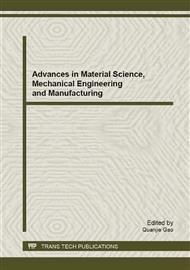p.31
p.35
p.40
p.44
p.49
p.53
p.58
p.63
p.68
Optimization Design Research on Descaling Bit of Water Pipeline Wall
Abstract:
Water pipeline scaling serious by prolonged use, result in a substantial diameter narrowed, reduced water efficiency. Mechanical cleaning is a kind of economic and security cleaning method, current drilling scaling equipment cannot clean effectively. In order to solve this problem, analyzes the dill descaling method. Choose multi-tooth bit as a foundation. Established finite element model for static analysis, gets three direction force diagram. Optimal design drill structure, created a new type of scaling drill. Compared two kinds force analysis results, by improving the structure, distributed stress on multiple cutting tooth, improved cutting conditions, enhanced the drill descale and feed ability, and improved the working life of the unit. Carried out static and dynamic finite element analysis, provide a theoretical basis for follow-up design.
Info:
Periodical:
Pages:
49-52
Citation:
Online since:
August 2013
Authors:
Price:
Сopyright:
© 2013 Trans Tech Publications Ltd. All Rights Reserved
Share:
Citation:


